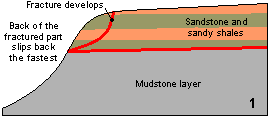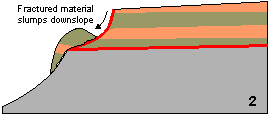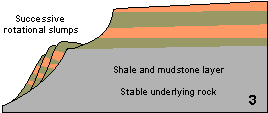Stage 1

Geology:
Underlying layers of mudrocks - these were deformed and weakened during the Loch Lomond Stadial (after the last ice age).
Glacial action exposed upper series of thin sandstone bands. These are hard competent strata, overlying weakened mudstones.
Valley glaciation left the slopes over steepened and unstable.
These factors cause slopes to be unstable.
Stage 2

Joints in the gritstone units become enlarged, allowing fractures at the slope edge.
Groundwater in the gritstone beds puts pressure on the fracture zone.
Melting of glacial ice also caused extra pressure on the slopes.
Water reacts with clays in the shales and weakens the slope yet further and eventually, the slope fails.
Stage 3

The first forward movements of the displaced strata leaves the valley sides further weakened and unstable.
Further slumping of the slope is then triggered by:
- stream undercutting,
- valley floor instability,
- sandstone aquifers at the valley floor,
- strata inclined towards the valley floor,
- heavy rain,
- high water tables,
- deposition of glacial material over slopes.
Causing successive slope failures.